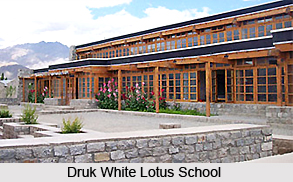 Education in Ladakh was mainly based on the education given by the monasteries. The schools of Ladakh teach Tibetan, Urdu, English, Geography, Sciences, Nature study, Arithmetic, Geometry along with Bible study.
Education in Ladakh was mainly based on the education given by the monasteries. The schools of Ladakh teach Tibetan, Urdu, English, Geography, Sciences, Nature study, Arithmetic, Geometry along with Bible study.
The conservative village people of Ladakh were somehow reluctant to send their children for formal education. As per the 2001 census, the overall literacy rate in Leh District is 62% among which 72% for males and 50% for females, and 58% in Kargil District which involves 74% males and 41% females.
To improve the education system in Ladakh the Moravian Mission established a school in Leh in October 1889, and it was ordered from the Wazir-i Wazarat authority that at least one child from each family should go to schools for proper and formal education. In 1973, the first local school was established to provide western education by a local Society called "Lamdon Social Welfare Society". Later with support from HH Dalai Lama, and some other international organisations the school has attained recognition and is considered to be one of the known institution for preserving Ladakhi tradition and culture. Moreover, the Druk, White Lotus School, located in Shey also has objectives at helping to maintain the cultural traditions of Ladakh. Most of the schools of Ladakh provide primary education and some of the schools provide higher secondary education.
The problem in the education system of Ladakh was intensified by the fact that there is no standard written form of colloquial Ladakhi. As a result in the system of education in Ladakh from the start the children were obliged to pursue their studies in a foreign language, Urdu (the official language of the state administration) and English for the higher secondary stage. The private Lamdron School in Leh, founded in the mid 1970s eliminated Urdu from the curriculum, making English the medium of instruction right from the primary classes, and introducing the study of literary Tibetan. A few years later, with the assistance of the German Moravian Church, which retained fond memories of its defunct mission in Ladakh, a Christian school was founded, at which the quality of instruction was a distinct improvement on what was on offer in the Government schools. Similarly with the Suru Valley Public School, and other schools founded by groups of private citizens in the Kargil district, including one at Dras., the education in Ladakh received a momentum.
The Students` Educational and Cultural Movement of Ladakh (SECMOL) launched `Operation New Hope` (ONH) in 1994. And with this the education in Ladakh gained a whole new facet. Operation New Hope` was a campaign to cater `culturally appropriate and locally relevant education` and make government schools more functional and effective in their mission to educate the children of Ladakh. By the summer of 1995, ONH principles were being implemented in no fewer than 35 government schools.
With the progression of time education in Ladakh improved as the consciousness of people was raised to some extent towards educating their children and as a result a government degree college was opened in Leh. This enabled students to pursue higher education. The education system of Ladakh is based on the Indian education system and the SECMOL has undertaken some programmes in 1993 that include producing Ladakhi textbooks, adopting one language for the teaching of mathematics and science at all ages, and the regular training of teachers.
Apart from primary education, an exciting development in the education system in Ladakh happened since the mid 1980s. The traditional system of medicine the Tibetan `amchi` system was encouraged as a trustworthy medical educational system. . In old Ladakh, `amchis`, like monks, used to proceed to Lhasa to get their training in the medical college there. An urgent need is also felt by the authorities of Ladakh for the development of an appropriate philosophy of education to ensure that the school curriculum is relevant to Ladakh, including the preservation of its endangered heritage of music and oral literature. The system began to run down after the Chinese occupation of Tibet in 1959. Its revival was initiated in the Leh district by the Leh Nutrition Project (LNP) of the Save the Children Fund, an international agency active in the region since 1979 and served mainly (now exclusively) by local people.
Apart from `amchis`, since 1960, the Ladakhis started going in for Western education and the qualified people of this sector choose to return and make their career in Ladakh. As far as education is concerned, it aims to fill some of the gaps in the Government system. It has sponsored some bright boys from far-flung villages to study in Leh, and in co-operation with the Lions` Club has set up a hostel in Leh for such boys.



















